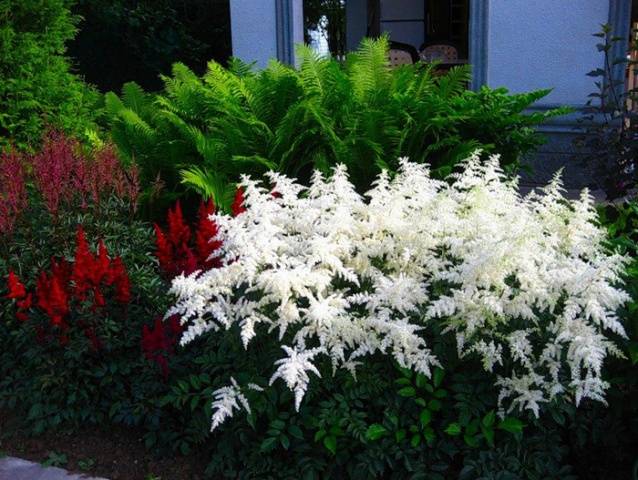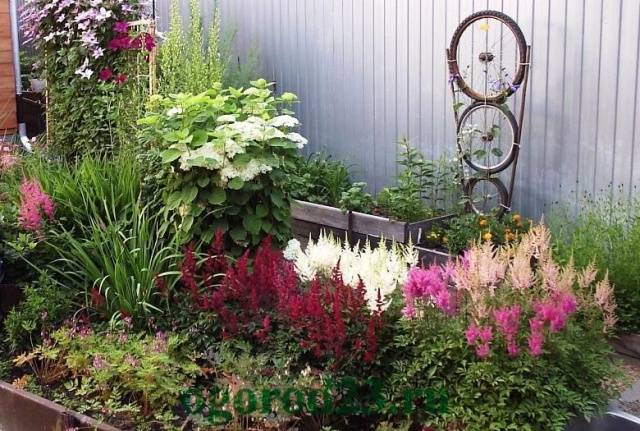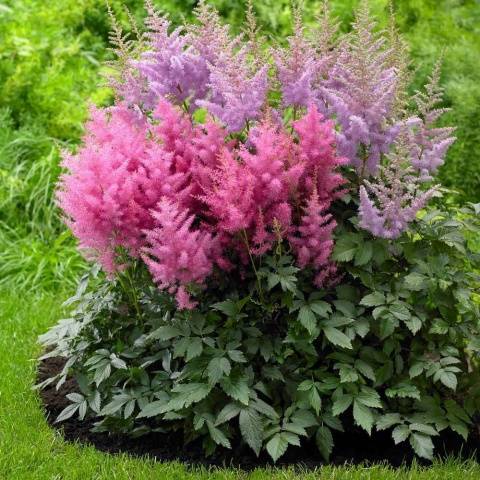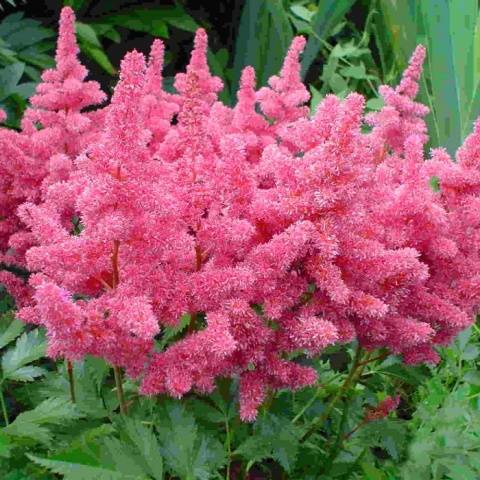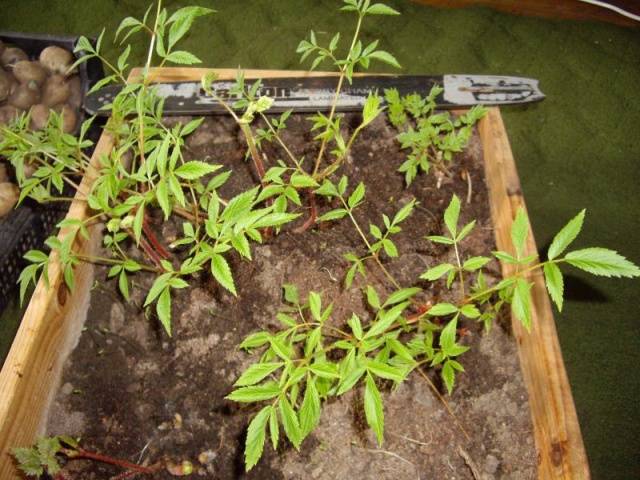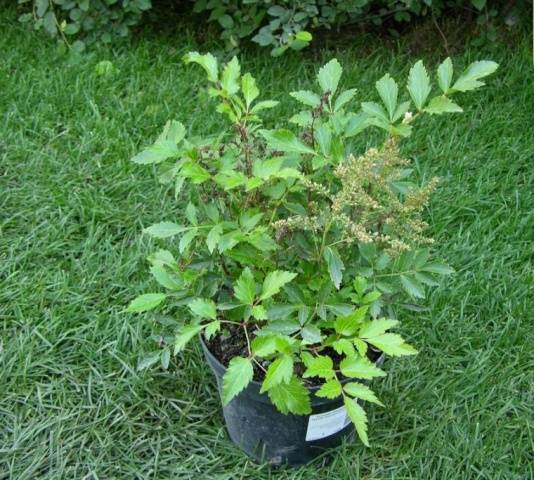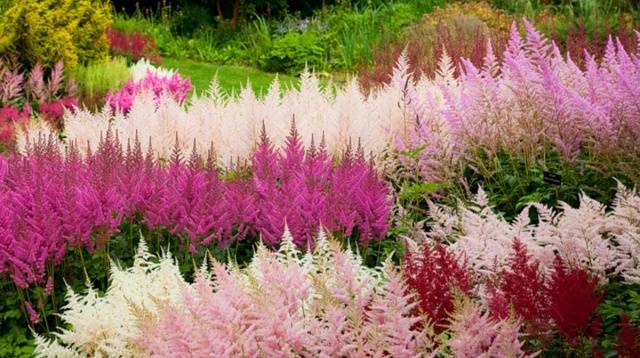Content
Astilba is ideal for decorating shady corners of the garden. Plants look good in single and group plantings.
Astilba blooms profusely with regular watering and feeding. The size of the bush and the color scheme depend on the variety. The flower is resistant to frost, tolerates temperature fluctuations well in summer. The plant is rarely more and less susceptible to attack by pests.
Botanical description
Astilba is a herbaceous perennial plant of the Saxifrag family. Naturally occurs in North America, China and Japan. Prefers deciduous forests, river banks and streams. In Europe, the flower has been grown since the 18th century. The plant adorns shady areas of gardens and greenhouses.
The flower has a powerful rhizome, the aerial part dies off in late autumn. The stems of the plant are erect, reaching 2 m. The leaves are green, sometimes with a reddish tint, petiolate, simple or feathery.
Astilba flowers are collected in apical inflorescences in the form of a panicle or pyramid. The color scheme includes white, pink, red, lilac shades. Flowering, depending on the variety, begins in June - August.
Astilba Arends includes more than 40 varieties. The varietal group is characterized by powerful sprawling bushes up to 1 m high. Inflorescences in the form of a ball or pyramid, white, red, pinkish. Flowering begins in July and lasts for 40 days.
Chinese hybrids reach a height of 1.1 m. The leaves are large, inflorescences up to 40 cm long. The flowers are lilac, purple or white. Representatives of the group grow well in illuminated areas.
Photo of flowers of the Chinese variety Purpurlanze:
Japanese astilbe is up to 80 cm high. Pink or white paniculate inflorescences bloom in June. All varieties are resistant to cold snaps.
Common-leaved astilbe is a compact plant up to 50 cm high. Drooping inflorescences look spectacular on the site. The color scheme is presented in white, pinkish and coral shades.
Astilba looks good in group and mixed plantings. Low-growing varieties are used to decorate borders and reservoirs. The plant is combined with geyher, hosts, fern.
Seeds of producers Gavrish, Center-Ogorodnik, Agronika, Aelita are on sale. Agrofirms sell both individual plant varieties and their mixtures.
Growing astilba
At home, astilbe is grown from seeds. The emerging seedlings are provided with the necessary conditions. When warm weather sets in, the plants are transferred to the garden bed.
Planting seeds
There are certain dates when to plant astilba seedlings. The works are carried out in March-April. First, prepare the substrate and process the seeds. For growing astilbe take equal amounts of sand and peat.
The soil mixture is steamed in a water bath to destroy pathogens. Another disinfection option is to refrigerate the soil. At sub-zero temperatures, the soil is kept for several months on the street or balcony.
For disinfection, the planting material is placed in a Fitosporin solution. The use of the drug allows you to grow healthy and strong seedlings. s
To grow astilba from seeds, containers 15 cm high are prepared.To avoid picking seedlings, cassettes with a mesh size of 5 cm are used.
Seed planting procedure:
- The containers are washed with hot water and filled with soil.
- A layer of snow 1 cm thick is poured on top. If there is no snow cover, you can use the ice from their freezer.
- Astilba seeds are poured onto the snow.
- After the snow melts, the seeds will be in the ground. Then the container is wrapped in a plastic bag and left in the refrigerator for 20 days.
The change in temperature stimulates seed germination. When shoots appear, the containers are transferred to a warm, lighted place.
Seedling conditions
Astilbe seedlings provide a number of conditions, which include temperature, soil moisture and lighting.
Microclimate for growing astilba from seeds at home:
- temperature 18-23 ° C;
- lighting for 12-14 hours;
- regular watering;
- airing the room.
If the duration of daylight hours is insufficient for seedlings, then the installation of phytolamps or fluorescent devices is required. Lighting is placed at a distance of 30 cm from the seedlings. Lamps turn on in the morning or evening.
Plants are watered with warm, settled water. Moisture is applied at the root until the topsoil dries. To avoid high humidity, the room is periodically ventilated. Landings are protected from drafts.
With the development of 2-3 leaves in astilba, it is seated in separate containers. To minimize stress on plants, they are transferred to new containers along with an earthen ball.
2-3 weeks before transfer to the ground, they begin to harden the seedlings. Plants are kept for several hours on a balcony or loggia. This period is gradually increased. Hardening will help the astilbe adapt faster to its natural environment.
Landing in the ground
When growing astilba from seeds, it is transferred to the garden bed in May-June after the establishment of warm weather. For plants, northern areas that are in the shadow of buildings or fences are suitable.
The flower grows well next to trees and shrubs. When planted in an illuminated area, astilbe blooms profusely, but for a shorter period.
The plant prefers loamy soils. The high location of groundwater provides soil moisture. In the spring, the site is dug up and fertilized with compost in the amount of 2 buckets per 1 sq. m.
When to plant astilba seedlings in open ground depends on the climatic conditions of the region. It is necessary to wait for warm weather and the last frost.
The procedure for planting seedlings in the ground:
- Preparation of planting pits measuring 20x20 cm and a depth of 30 cm.A gap of 30 cm is left between the plants.
- At the bottom of each pit, 1 tbsp is poured. l. diammophos and 1 glass of wood ash.
- Planting holes are watered abundantly with water.
- Seedlings are also watered and taken out of containers.
- Astilba is placed in a pit, the growth buds are buried 4 cm.
- The roots of the plants are covered with earth, which is well tamped.
- The soil is mulched with peat, the layer thickness is 3 cm.
Astilba care
Astilba is an unpretentious plant that requires minimal maintenance. In one place the flower grows for 5-7 years, with regular care this period reaches 10 years. The plantings are watered and periodically fed. In late autumn, the plants are prepared for winter.
Watering
During the season, you need to monitor the moisture content of the soil. Astilba watering intensity depends on weather conditions. With heavy rainfall, watering is minimized. In a drought, the plant is watered 2 times a day.
Photo of astilba flowers:
After watering, loosen the soil and weed weeds... After loosening, the plants absorb moisture and useful components better. It is recommended to hud up the bushes.
Top dressing
Astilba grown from seeds reacts positively to feeding. During the season, fertilizers are applied 3 times:
- in the spring after the snow melts;
- in mid-June;
- after the end of flowering.
For the first feeding, nitrogen fertilizer is prepared. Nitrogen stimulates the development of new shoots. When hilling, rotted compost is introduced into the soil. Of the minerals for plants, urea or ammonium nitrate is used. 20 g of the substance is dissolved in 10 l of water, after which watering is performed.
The second treatment is carried out using potassium nitrate. Take 2 tbsp for a bucket of water. l. fertilizers. After flowering, the plant is fed with superphosphate. 25 g of the substance is embedded in the ground or added to the water during irrigation.
Diseases and pests
Astilba rarely suffers from disease. When growing astilba from seeds, diseases can be avoided when processing planting material.
With an excess of moisture, the plants are affected by root rot and spotting. Brown or black spots appear on the affected bushes. Plants are sprayed with copper-based preparations and transplanted to a drier area.
Of the pests, astilbe attracts pennits and nematodes. Insects feed on plant sap, as a result, the flowers lose their decorative properties, begin to deform and wither. For pests, drugs Karbofos or Aktara are used.
Autumn works
Astilba inflorescences retain their decorative properties for a long time. Therefore, they are not cut off, but left on the bushes in a semi-dry form.
At the end of the season, plants need special care to prepare them for winter. The stems of the flower are cut at the root.
Plants are mulched with dry leaves and covered with spruce branches. If there is a lot of snow in the region, then additional cover is not required. The flower tolerates frosts down to -35 ° C.
Conclusion
Astilba is an unpretentious plant that blooms profusely in the shade. The flower is grown from seeds that are planted at home. Seedlings are provided with a number of conditions, including temperature, watering and lighting. The grown flowers are transferred to a permanent place. When feeding and adding moisture, Astilba pleases with abundant flowering.
